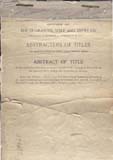Clinton Heights Avenue Trivia
 I recently had the benefit of reading an abstract from one of the north-side-of-Clinton-Heights-Avenue residents.
I recently had the benefit of reading an abstract from one of the north-side-of-Clinton-Heights-Avenue residents.
A couple interesting things from the abstract:
Calumet Street, according to the abstract, used to be called “Oak Hill” before the name was changed to “Beech Hill,” and then changed to “Calumet.”
The alley along the north side of Clinton Heights traversed through the school property and then to North Broadway. I have often wondered about this vacated alley, which runs behind the properties along the north side of Clinton Heights Avenue and the south side of East North Broadway. It’s a recessed, ravine-like greenspace that doubtless has many city services running along its banks. You can see this alley in the 1910 and 1920 maps on my web site. The rumor passed to me by former Clinton Heights neighbors was that the North Broadway residents had petitioned the city to vacate this alley, but when the city approved the request, they gave the alley property to the residents of Clinton Heights Avenue instead of splitting it between the residents of the two streets.
The abstract gave me specifics of the vacating. By ordinance No. 38053 duly passed by the Council of the City of Columbus, Ohio, on May 2, 1927, the first alley north of Clinton Heights Avenue “from Beech Hill Avenue to the west line of lot 68,” 12 feet, wide, was vacated. (No indication in City Council minutes of who actually submitted the petition, and I have not bothered to look.) The City Council minutes are attached <here>.
More about the land that became Clinton Heights Avenue…
Henry Cooke once owned part of the property that was later developed into the Clinton Land Company addition.
I have often read an old anecdote that James Chesnut (sometimes spelled “Chestnut”), who owned the house on Wall Street, had blocked the improvement of North High Street along his property near Brighton and North High Street, because a beloved locust tree would be damaged or removed by the paving. The abstract bore some of this out. In the abstract (relevant pages linked here), the property developers were assessed $5400 for improvements in the Worthington and Columbus Plank Road, but, they said, these improvements were never made, because James Chesnut (and others) “were defendants procuring an injunction perpetually enjoining the making of said improvements along his premises.” The Clinton Land Company owners sued, or perhaps countersued, stating that they had been assessed conditional on improvement of North High Street, which improvements had not been made. Who won: You can read the attached excerpts of the abstract and decide for yourself.
April 23rd, 2011 at 5:15 pm
Great information Shirley. I was in 4-H when I was a teen.
I had reveiwed an abstract on North Broadway that indicated Oak Hill as the street that ran west to east between the RR and Indianola.
In 1910, Charles Evans owned significant land holdings to the east of the railroad. According to the abstract, he jointly owned, with Loren and Dennison (the original developers of North Broadway), all of the East North Broadway lots to the east of Indianola. The abstract indicated that Evans requested that the road (ENB) not be improved beyond Indianola. The road was built and Evans refused to pay the assessment. Ultimately, he lost his ownership interest in the lots on the north side of ENB and the lots to the east of his property on the south side.
I think Evans owned the house that was at 625 East North Broadway. Newspaper articles from 1890 state that he had recently built a home on East North Broadway and this location would make sense based on his other land holdings.
The Carriage House of the 625 ENB home still stands at 4 Broadway Lane. It could have been easily accessed from Oak Hill prior to the building of East North Broadway.
Evans was a railroad freight agent. He becomes one of the Hocking Hills Coal developers. In the early days, North Broadway and the area south to Lane is called Evanston. I think that is a reference to Charles.
I thought I saw a reference to Calumet being called “School Children’s Lane”. Have you seen anything with that reference.